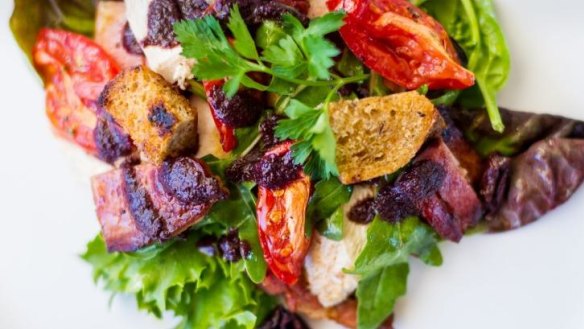Bryan Martin's olive and chicken salad recipe

One of the best things I've discovered in the past 10 years – and I know what you're thinking, and as handy as the knowledge is, that when you get into a new car, or a friend's car, or are even allowed to drive your partner's car, and you pull up at a servo and think, "Which side is the fuel tank on?" knowing that if you look down at the fuel gauge, there's a little arrow next to it which will tell you which side the tank is on, but it's not just that – it's the fact that having an Italian friend pays dividends big time.
Apart from being pretty cool-looking people in general, they will have these skills that come in handy for all sorts of reasons. Firstly they will naturally, once the weather cools down in April, like now, start curing pork. They probably don't know they are doing it, salume making is just in their blood like plundering and pillaging is to the Swedes. Also, Italians will always be thinking about making wine in their sheds. They vary in success, I have to say, but they certainly are passionate at it. Every year we get groups of men wanting to buy grapes and bring you last year's to show you how good their techniques are.
The classification system has two levels – wine or the distilled fiery biofuel called grappa. Then, of course, Italians are great concreters, goes back thousands of years. A house isn't finished unless it has a Roman column or two but a slab made by an Italian will still be here in another thousand years.
However, it is the love of olives and olive oil that has my attention this week. The job just after picking the grapes and salting the pork is to harvest the olives. Around here olives are generally grown for their oil, and what a fantastic oil it is. Peppery, floral, sometimes herbal, I don't grow them myself on account of olives being one of the worst crops to pick. So I barter winemaking for the oil each year. In fact, I don't think I've really bought olive oil for over 10 years now and look forward each year to the freshly pressed oil to arrive. It's cloudy and takes a few months to settle but has so much olive flavour and freshness.
In warmer years you will also get the table olives ripe. This being a great year means that the olives will be large, ripe and perfect for salting and drying. If you don't know an Italian to barter with, you should be able to find olives at the markets. Choose big, plump, black olives and get plenty of salt, too. This process is the best I've found, just use half the weight of the olives in salt. Soak the olives in water for a few days, changing the water every day. Mix together the salt and olives, and put them in a porous bag set over a basin to collect the black muck. Have them somewhere warm but out of the weather and shake them gently each day. It'll take two to three weeks for the process to finish; toward the end you need to taste the olives and once they taste sweet they are ready to pack away in olive oil.
Olives treated this way have an added intensity and are great blended, with their pips removed, to make a tapenade. You can mimic this by air-drying store-bought olives. You won't quite have the glow of making them from scratch but worthy they are. Here I've just knocked together a late autumn salad with juicy roasted chicken breast, some smoky bacon, some left over sourdough and the season's last tomatoes.
Salad of seared chicken breast with smoked speck, tomato and dried olive tapenade
2 chicken breasts
200g smoked speck, sliced into thick rashers
10 small plum tomatoes
200g large black olives, pitted
2 tbsp salted capers, rinsed
1 clove garlic, peeled
3 anchovy fillets
day-old sourdough bread, diced
mixed lettuce leaf
red wine vinegar
flat leaf parsley, chopped
olive oil, salt and black pepper
Halve the olives and lay them on a baking sheet and dry in an oven set at 60C. If you have a food dehydrator this will also work. Dry until the olives have shrivelled significantly but not so they will blow away in a breeze. Add these to a blender with the capers, garlic and anchovy and about six leaves of parsley. Blend to a paste adding olive oil until you have a fairly runny condiment.
Bring a pot of water to the boil, make a small cross cut at the base of the tomatoes and plunge into boiling water briefly, then drain and chill quickly in iced water. Slip the skins off and cut in half, season with salt and pepper. Brush with olive oil and place on an ovenproof tray.
Set the oven to 200C, bring a heavy-based frypan up to heat and cook the speck until it's nice and crispy; set aside. In the grease left behind, fry the sourdough pieces until they are crispy; set aside.
Clean out the pan and get it really hot. Season the chicken breast on both sides with salt and pepper. Splash some olive oil into the pan and sear the chicken on both sides until it has good colour. Place in oven, along with the prepared tomatoes, for eight minutes or until the chicken is just cooked through. Rest the chicken breast briefly and slice across into half a dozen thick slices.
Toss the salad leaf in a little oil and vinegar, arrange in the centre of a fetching plate and pile up the chicken, speck and tomatoes, drizzle with tapenade and finish with sourdough croutons and parsley.
The best recipes from Australia's leading chefs straight to your inbox.
Sign up